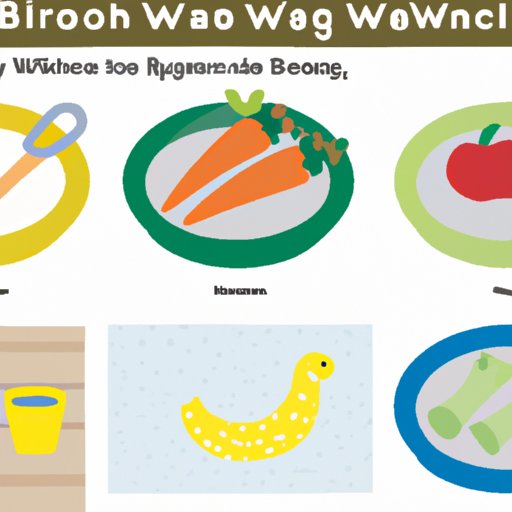Introduction
Introducing solid foods is an exciting milestone in a baby’s development. However, it can also be intimidating for parents as they navigate this new stage. Baby-led weaning (BLW) is an approach to introducing solid foods that has become increasingly popular. It allows babies to explore food at their own pace and encourages them to develop their independence. In this article, we will provide an overview of BLW, discuss its benefits, and provide tips on how to get started.
Overview of Baby-Led Weaning (BLW)
Baby-led weaning is an approach to introducing solid foods that involves allowing babies to feed themselves with age-appropriate finger foods, rather than spoon-feeding pureed or mashed foods. The goal of BLW is to allow babies to explore different textures and flavors while developing their motor skills and learning to self-regulate. It is important to note that BLW does not replace breastmilk or formula; these should still be offered until the baby is 12 months old.
Benefits of BLW
There are many benefits to introducing solid foods using the BLW approach. First, it allows babies to explore different textures and flavors at their own pace. This helps them develop their palates and learn to enjoy a variety of foods. Second, it encourages babies to use their hands and fingers to explore and manipulate food, which helps to develop their fine motor skills. Third, it gives babies a sense of independence and autonomy, which can help them feel more secure and confident when trying new foods. Finally, BLW can save time and money, as there is no need to buy or prepare special foods.
Preparing Food for BLW
When preparing food for BLW, it is important to offer a variety of healthy, nutritious options. Foods should be soft enough for the baby to chew and swallow easily, but not so soft that they turn to mush in the baby’s mouth. Examples of foods to offer include thinly sliced fruits and vegetables, cooked pasta, cooked grains, small pieces of cooked meat or fish, beans, and avocado. All foods should be cut into small, bite-sized pieces to prevent choking.
Foods should also be prepared in a way that makes them safe for the baby to eat. All foods should be cooked thoroughly and served at room temperature, as the baby may not yet have the ability to recognize if food is too hot. Additionally, all foods should be cut into small, bite-sized pieces and checked for choking hazards (such as pits, bones, or large chunks).
Finally, it is important to ensure that all surfaces and utensils used for preparing food are clean and free from bacteria. This includes cutting boards, knives, and any other items that come into contact with the food.
Introducing Solid Foods
It is recommended that babies be introduced to solid foods between 4 and 6 months of age. Before introducing solid foods, it is important to observe the baby for signs that he or she is ready to start. These signs include being able to sit up independently, having good head control, showing interest in food, and being able to pick up food and put it in his or her mouth.
When introducing solid foods, it is important to do so gradually. Start by offering a few bites of food at a time and increase the amount as the baby becomes more comfortable. It is also important to offer a variety of foods and flavors to expose the baby to different tastes and textures. Finally, it is important to keep mealtimes fun and relaxed. Encourage exploration and play with the food and don’t worry if the baby doesn’t eat much at first.
Creating a Safe Environment
When introducing solid foods, it is important to create a safe environment for the baby to explore. Supervision is key; never leave the baby unattended during mealtimes. Additionally, it is important to ensure that the baby is seated in an appropriate chair or booster seat and that the eating surface is stable and at the correct height. Utensils designed specifically for babies should also be used, such as spoons with wide handles and shallow bowls.
Recipes and Ideas for Nutritious Meals
Once you have mastered the basics of BLW, you can begin to explore more creative recipes and ideas for nutritious meals. Examples of meals for BLW include scrambled eggs, roasted vegetables, quinoa bowls, and omelets. For snacks, try offering fruit slices, yogurt, cheese cubes, or vegetable sticks. For busy parents, simple meals like sandwiches, smoothies, and toast are great options.
Conclusion
Baby-led weaning is an approach to introducing solid foods that has numerous benefits. It allows babies to explore different textures and flavors at their own pace, encourages them to use their hands and fingers to manipulate food, and gives them a sense of independence and autonomy. To get started with BLW, it is important to prepare safe, nutritious foods, introduce solids gradually, create a safe environment, and explore recipes and ideas for nutritious meals. With the right preparation and guidance, BLW can be a fun and rewarding experience for both baby and parent.
(Note: Is this article not meeting your expectations? Do you have knowledge or insights to share? Unlock new opportunities and expand your reach by joining our authors team. Click Registration to join us and share your expertise with our readers.)
